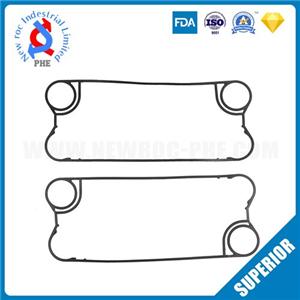Heat exchange plate structure of plate heat exchanger
The plate heat exchanger is composed of a set of corrugated parallel metal heat exchange plates. There are passage holes at 4 corners of the heat exchange plates. The heat exchange plates are clamped on a fixed plate with connecting pipes on the side. And the frame of the movable compression plate, and clamped with clamping bolts. These connecting pipes are aligned with the channel holes on the heat exchange plate and connected to the external pipelines of the two liquids for heat exchange. The heat exchange plate and the movable compression plate are suspended under the top load beam and are aligned by the bottom cross beam. Quasi-positioning.
The heat exchange plate itself has a specific shape and is sealed by a fixed heat exchange gasket to prevent external leakage, and the two liquids of heat exchange flow alternately between another pair of heat exchange plates in a countercurrent manner. In the channel. The corrugations on the heat exchange plates not only increase the turbulence of the fluid, but also form many contact points to withstand the normal operating pressure. The fluid flow rate, physical properties, pressure drop and temperature difference determine the number and size of the heat exchange plates. The herringbone corrugated heat exchange plate has a high degree of turbulence, and high turbulence can also give full play to the cleaning effect, which can be particularly effective in minimizing deposited dirt. However, the corrugated plate has more contact points. When the liquid water quality is poor, it contains suspended solid particles. , Sundries and aquatic plants, etc., due to the narrow gap between the plates, so as far as possible to ensure that all particles larger than 2mm are filtered out before entering the heat exchanger. If the filter does not function effectively, it will be prone to blockage. .
The cooling water and the cooled water of the plate heat exchanger are convective on both sides of the corrugated plate. The corrugation adopts herringbone corrugation. The corrugations of these heat transfer plates are oblique, that is, the adjacent heat exchange plates have the same inclination angle but different directions Of ripples. The cross-sectional area along the flow direction is constant, but the continuous change of the flow direction causes the shape of the flow channel to change, causing turbulence. Generally, the corrugation depth of the heat transfer plate is 3~5mm, the flow velocity in the turbulent zone is about 0.1~1.0m/s, the heat exchange plate is very thin, the thickness is 0.6~1mm, and there must be many contact points between adjacent heat exchange plates to withstand Under normal operating pressure, adjacent plates have herringbone grooves in opposite directions, and the intersection of the two grooves forms a contact point, which can also eliminate vibration, and while promoting turbulence and heat exchange, eliminates fatigue Internal leakage caused by cracks.
In the plate heat exchanger, the cooling water side and the cooled water side flow uniformly and turbulently. The two fluids flow in the opposite direction. The turbulence is caused by the action of the corrugation, resulting in high heat transfer rate, high resistance pressure drop and high shear stress field. This results in inhibiting the formation of dirt on the heat transfer surface. The heat transfer coefficient is generally 3500~5500w/(m2.k), thus, the heat exchange area of the heat exchanger can be saved. Since the two medium flow passages are basically the same and the heat transfer efficiency is high, the plate heat exchanger can greatly reduce the cooling water volume. Generally, the ratio of the cooling water volume to the cooled water volume is 0.8 to 1.1:1, which can reduce the installation of pipeline valves and pumps. Operating expenses.
The plate heat exchanger has the characteristics of small size, light weight, convenient maintenance, and no maintenance and lifting facilities are required, so the installation takes up less space. Manual maintenance of the plate heat exchanger includes folding the whole machine apart, cleaning the heat exchange plate and heat exchange gasket with a spray gun and brush, checking the heat exchange plate and heat exchange gasket, and replacing the heat exchange plate if necessary And replace the heat exchange gasket. Plate heat exchangers generally need to be cleaned once a year, regardless of actual needs. When using cooling water with poor water quality such as river water and sea water, there is a danger of surface pollution and blockage due to the presence of sediment and dirt, as well as the rapid growth of microorganisms. When river water is used as cooling water, the cleaning frequency is very high, 3.3 times per year on average.




